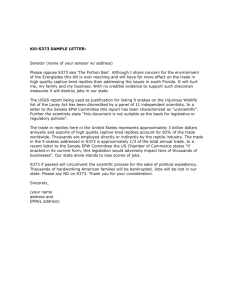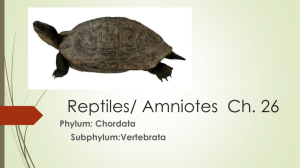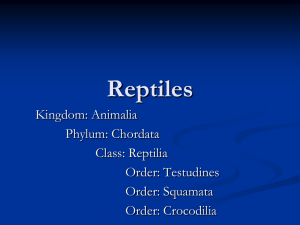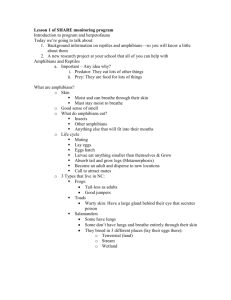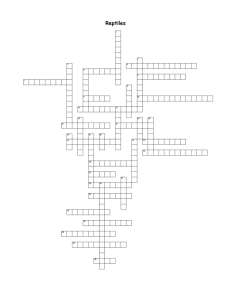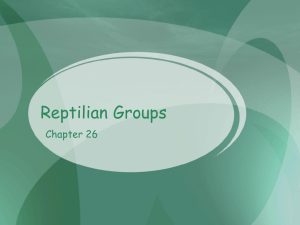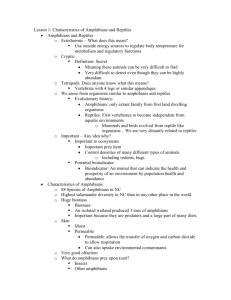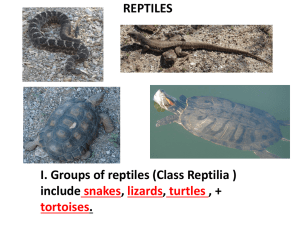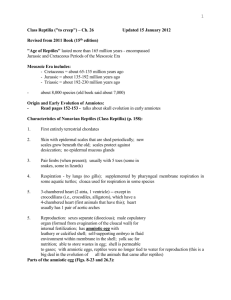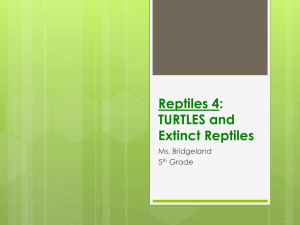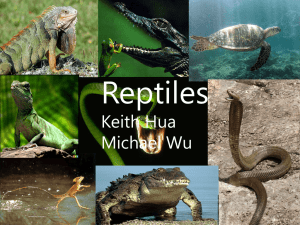Reptiles - Rockwood Staff Websites Staff Websites
advertisement
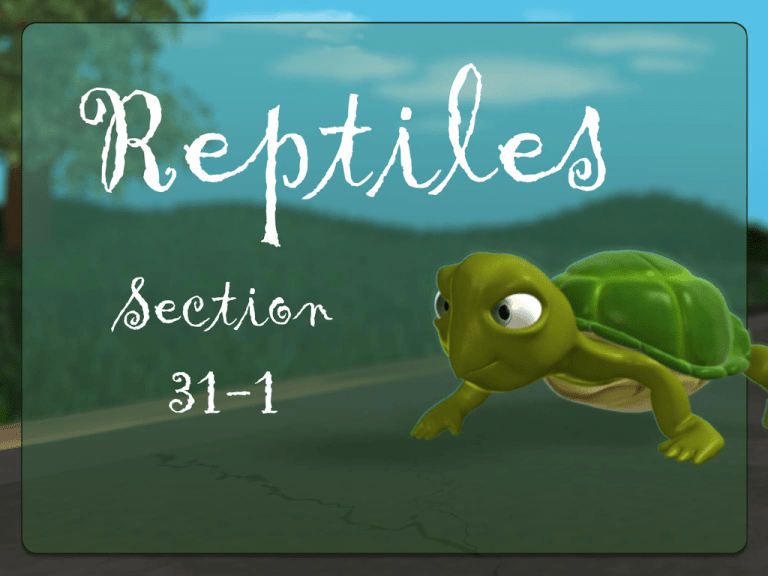
Reptiles Section 31-1 Section 31-1 Learning Targets • Describe the characteristics of reptiles • Explain how reptiles are adapted to life on land • Identify the four living orders of reptiles Classification • Kingdom: Animalia – Phylum: Chordata •Subphylum: Vertebrata –Class Reptilia What is a Reptile? • • • • • Vertebrate Dry, scaly skin Breathe with lungs Terrestrial eggs Internal fertilization Form & Function • BODY TEMP CONTROL – ECTOTHERMS: rely on external environment to control temp • Lay in sun to warm up, move in shade to cool down • Feeding – Reptiles can be herbivores or carnivores – Most are carnivores that eat insects Form & Function • RESPIRATION: – LUNGS: spongy, so more gas exchange than amphibians • NO gas exchange thru skin – Muscles expand rib cage to inhale – Collapse the cavity to exhale Form & Function • CIRCULATION: – Efficient Double-Loop • One loop brings blood to and from the lungs • Other loop brings blood to and from the rest of the body – 2 atria; 1 ventricle (partially divided) – Alligators have 4-chambered heart • EXCRETION: – Kidneys produce urine • Nitrogenous wastes are excreted in the form of ammonia or uric acid • Aquatic reptiles usually excrete ammonia that has been diluted with water – Terrestrial reptiles usually excrete uric acid as crystals (conserves H20) Form & Function • RESPONSE: – Active during day; complex eyes; see color well – Detect smell and chemicals on roof of mouth • EX: snake flick tongue to bring chemicals into mouth • Some snakes can even detect the body heat of their prey! • REPRODUCTION – All reptiles reproduce by INTERNAL FERTILIZATION • Male deposits sperm inside body of female – OVIPAROUS (most) • Lay eggs that develop outside of body – Ovoviviparous (some snakes and lizards) Reproduction, cont’d. • Unlike amphibian eggs, which need to develop in water, the shell and membranes protect the reptilian embryo from drying out – Reptiles use an AMNIOTIC EGG (hard shell) • Four membranes surround the embryo inside the shell: – CHORION – YOLK SAC: serves as food supply – AMNION: fluid-filed sac surrounds / cushions embryo – ALANTOIS Groups of Reptiles 4 Orders of Reptiles • Order Squamata ( Lizards and Snakes) • Order Crocodilia (alligators and crocodiles) • Order Testudines (Turtles and Tortoises) • Order Sphenodonta (Tuatara) Order Squamata • Snakes and Lizards – Evidence suggests that snakes evolved from lizards that burrowed – Snakes retain small leg bones even though they have no legs • Types of Lizards – – – – Komodo Dragon Gecko Chameleon Bearded Dragon • Types of Snakes – Cobra – Rattlesnake – Copperhead Frilled Lizard Gila Monster Horned Lizard Cobras and Coral Snakes • Cobras and Coral snakes – Inject a neurotoxin that causes paralysis and breathing difficulties Coral Snake Cobra Sea Snakes • Spend most of their life underwater • Tails are shaped like a paddle to help them swim Adders and Vipers • Adders and vipers – Very venomous Rattlesnakes • Rattlesnakes and water moccasins (cottonmouths) – Inject a hemotoxin which causes destruction of the blood and tissue – The area of the bite becomes swollen and dark. Copperheads Order Crocodilia • Crocodiles, Alligators, Caimans and Gavials • Only reptile group that takes care of their young (very protective of young) • Adapted to stealth hunting - eyes and nostrils are above the head, so the body can remain submerged – They attack when animals (or humans) come to the water shore to drink • Crocodiles – Pointier snout and teeth stick out – Live in fresh or salt water in Africa, India and Southeast Asia • Alligators – Snout that is more rounded and teeth fit into a socket – Live only in fresh water and are almost exclusively in North and South America Crocodiles Alligators Order Testudines • Turtles and Tortoises – Characterized by a shell that is fused to the turtle's spine • It cannot be removed, nor can a turtle crawl out of it. – The top of the shell is the carapace, the bottom of the shell is the plastron. • Turtles - generally live in water – Sea turtles migrate long distances to lay their eggs at the same beach they were born at. • Tortoises - live on land and have rounded bodies Order Sphenodonta • Tuatara only surviving member • Known as a "living fossil" – They have survived unchanged for 150 million years • Has a “third eye” above brain can sense the level of sunlight (function unknown) • Only lives in New Zealand and is in danger of becoming extinct • Tuataras have distinctive head spikes That’s All folks! Backdrops: www.animationfactory.com - These are full sized backdrops, just scale them up! - Can be Copy-Pasted out of Templates for use anywhere!
